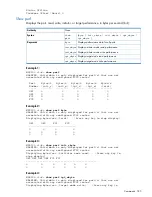
•
VPG configuration
requires the following commands:
The
“set VPGroups command” (page 175)
◦
◦
The
“show VPGroups command” (page 191)
•
LUN mapping
requires the use of the
“show lunmask command” (page 183)
.
Saving and restoring router configurations
Saving and restoring a configuration helps protect your work. You can also use a saved
configuration as a template for configuring other routers.
Persistent data consists of system settings, VPG settings, LUN mappings, discovered FC targets,
and discovered iSCSI initiators. To save a blade configuration and persistent data:
1.
Generate a file (
HP_StorageWorks_MPX200_FRU.bin
) containing the saved data by
entering the
fru save
CLI command.
This command stores the file locally on the router in an FTP directory.
2.
Transfer the saved data from the router to a workstation by executing an FTP utility on a
workstation.
The following example shows an FTP transfer to get the saved router configuration data:
c:\> ftp 172.17.137.102
Connected to 172.17.137.102.
220 (none) FTP server (GNU inetutils 1.4.2) ready.
User (172.17.137.102:(none)): ftp
331 Guest login ok, type your name as password.
Password: ftp
230 Guest login ok, access restrictions apply.
ftp> bin
200 Type set to I.
ftp> get HP_StorageWorks_MPX200_FRU.bin
200 PORT command successful.
150 Opening BINARY mode data connection for 'HP_StorageWorks_MPX200_FRU.bin'
(6168 bytes).
226 Transfer complete.
ftp: 6168 bytes received in 0.00Seconds 6168000.00Kbytes/sec.
ftp> quit
221 Goodbye.
Working with MPX200 router configurations
197






























